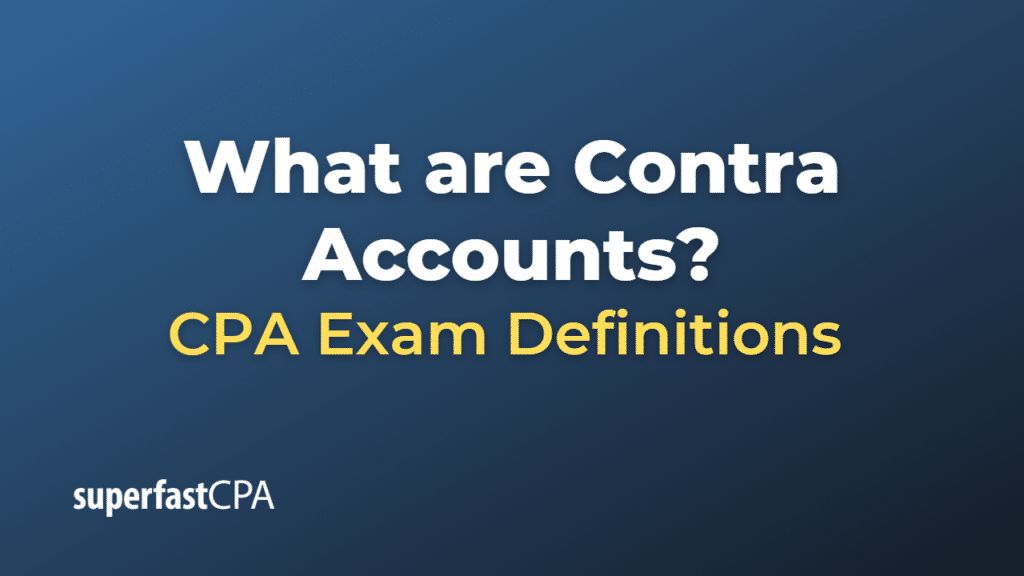Contra Accounts
Contra accounts are accounts used in financial accounting to offset the balance of a related account, effectively reducing the net balance of the paired accounts. Contra accounts are used to record adjustments, allowances, or discrepancies and to present the net value of the related account more accurately on the financial statements.
A contra account typically has a balance that is opposite to the normal balance of its associated account. For example, if the related account has a debit balance, the contra account will have a credit balance, and vice versa.
Some common examples of contra accounts include:
- Accumulated Depreciation: This contra account is paired with a fixed asset account (e.g., equipment, buildings, vehicles) and records the accumulated depreciation of the asset over time. The balance in this account increases as the asset depreciates, reducing the net book value of the asset on the balance sheet.
- Allowance for Doubtful Accounts: This contra account is associated with accounts receivable and records an estimate of the amount of receivables that may not be collectible. The allowance for doubtful accounts reduces the net accounts receivable reported on the balance sheet.
- Sales Returns and Allowances: This contra revenue account is used to record returns, refunds, or discounts given to customers for products sold. The balance in this account reduces the reported net sales revenue on the income statement.
- Purchase Discounts: This contra expense account is used to record discounts received from suppliers for prompt payment or other agreed-upon terms. The balance in this account reduces the reported net cost of goods purchased on the income statement.
Contra accounts provide more detailed information to financial statement users by showing both the gross and net amounts of the related accounts. They also help organizations track specific adjustments and discrepancies, allowing for better financial analysis and decision-making.
Example of Contra Accounts
Let’s consider a fictional example of a small business called “TechGadget” to illustrate the use of contra accounts in financial accounting.
TechGadget sells electronic devices and has the following related accounts and contra accounts:
- Accounts Receivable and Allowance for Doubtful Accounts:
TechGadget has an accounts receivable balance of $50,000, which represents the total amount owed by customers for purchases made on credit. However, the company estimates that around 2% of these receivables may not be collectible due to various reasons, such as customers going out of business or refusing to pay.
To account for this potential loss, TechGadget creates a contra account called “Allowance for Doubtful Accounts” with a credit balance of $1,000 (2% of $50,000). On the balance sheet, the net accounts receivable will be reported as $49,000 ($50,000 – $1,000).
- Equipment and Accumulated Depreciation:
TechGadget has purchased equipment worth $25,000, which has an estimated useful life of 5 years and no residual value. The company uses the straight-line method of depreciation, resulting in an annual depreciation expense of $5,000 ($25,000 / 5 years).
To record the depreciation, TechGadget creates a contra account called “Accumulated Depreciation – Equipment.” After the first year, the accumulated depreciation account will have a credit balance of $5,000, reducing the net book value of the equipment to $20,000 ($25,000 – $5,000) on the balance sheet. This process continues each year until the equipment is fully depreciated.
- Sales Revenue and Sales Returns and Allowances:
TechGadget has total sales revenue of $80,000 for the year. However, the company received returns and provided refunds to customers for defective products or other reasons, amounting to $3,000.
To account for these returns and allowances, TechGadget records the amount in a contra revenue account called “Sales Returns and Allowances.” On the income statement, the net sales revenue will be reported as $77,000 ($80,000 – $3,000).
These examples illustrate how contra accounts are used in financial accounting to provide more accurate and detailed information about the related accounts, allowing for better financial analysis and decision-making.













